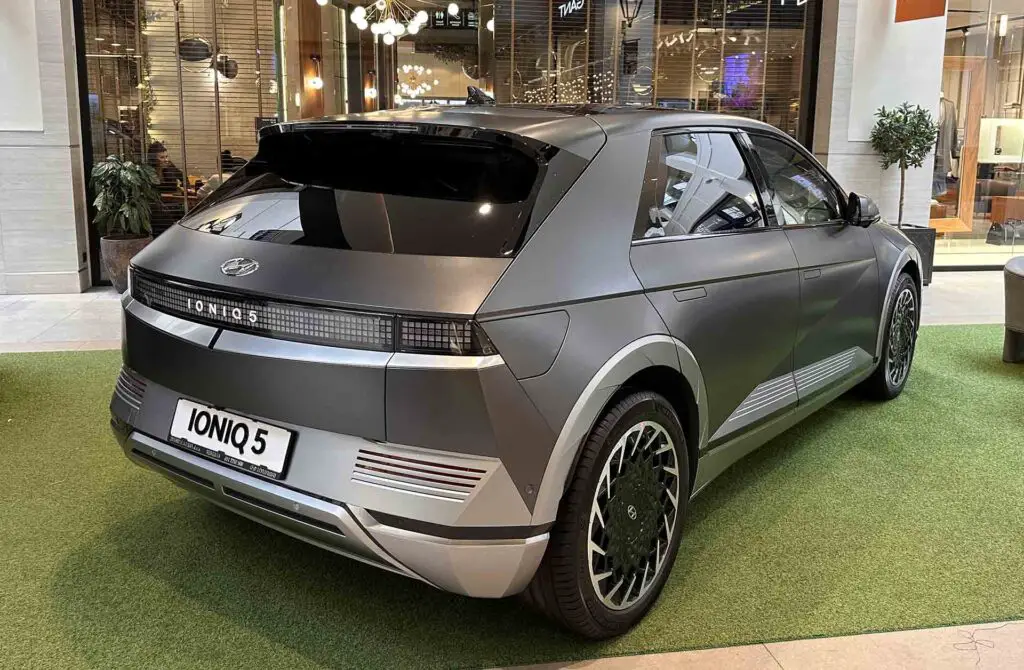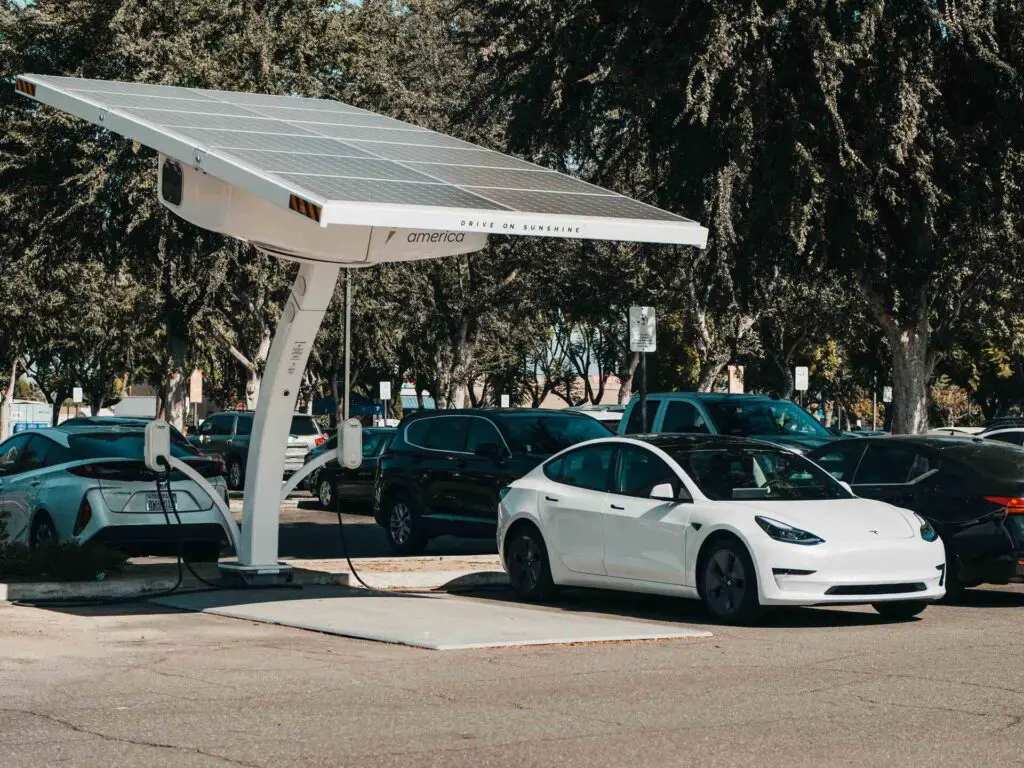There’s no stopping the electrifying evolution. It just keeps pushing the pedal to the metal, with no trace of hitting the brakes anytime soon. And now, there’s a dazzling new twist on the road – electric cars with solar panels. This sun-powered green vehicle technology is taking the driving experience to a whole new level. Let’s discover how exactly.
First Things First – Understanding the Mechanics of Solar Panels on Electric Cars
As we gaze at the future of electric mobility, there’s one exciting game-changer that emerges on the horizon – the photovoltaic technology in cars or, simply, solar panels. They are like tiny energy factories on your four-wheeler’s roof, capturing sunlight and diligently converting it into electricity.
How do they do it? Well, solar energy in vehicles should give its thanks to the magic of semiconductors. When sunlight hits these cells, it excites electrons, setting off a chain reaction that generates electrical current. Yes, it’s really as cool as it sounds – the sunlight literally turns into a power source.
Self-Charging EVs? Free Miles? The Possibilities Are Endless When It Comes to Renewable Energy in Transportation
Currently, electric vehicles primarily rely on charging stations and regenerative braking systems to juice up their batteries. When you slow down or brake, the EV converts some of that kinetic energy back into electricity to charge the battery. Now, here’s where this innovative technology comes into play. They should be able to complement the regenerative system, potentially adding thousands of “free” miles each year.
But the future holds even more promise. Solar battery integration in cars holds the promise of self-charging EVs. They could continuously recharge while parked, using sun rays to keep their batteries topped up. It’s not just eco-friendly – it might be the path to truly unlimited, emission-free driving.

Which Automakers Are Leading the Game of Manufacturing Electric Cars With Solar Panels?
As the sun rises on a new era of vehicle evolution, manufacturers are diving headfirst into solar-electric automotive technology. Many startups and concepts are at the forefront, promising a brighter, greener future on the road.
Let’s take a joyride through some of the industry leaders who are at the forefront of sustainable automotive design:
- Hyundai – the Ioniq 5 offers a panel roof option that promises to add up to 1,200 miles a year of additional range,
- Mercedes-Benz – this luxury automaker is gearing up to bring its panel roof Vision EQXX concept soon, which will allegedly be able to add up to 15 miles of range a day, or a whopping 3,750 miles a year,
- Fisker, Inc. – the Fisker Ocean offers an optional full-length panel roof that’s projected to add 1,500 miles per year to your adventures,
- Lightyear – these EVs are specifically designed for solar-powered driving, harnessing the sun’s energy with 54 square feet of boards, which can get you up to 43 additional miles per day,
- Sono Motors – the Sion, covered in solar-powered boards from bumper to bumper, promised an impressive 3,500 miles a year. Still, unfortunately, this interesting four-wheeler didn’t make it to the market.

The Sunny Side – What Are the Main Advantages of Solar Charging for Electric Vehicles?
Whenever something new rolls onto the scene, skepticism often follows. But it’s important to remember that innovations are born for a reason, each one carrying its own set of advantages and possibilities.
When it comes to the concept of an electric car with solar panels, this technology is definitely turning heads and raising eyebrows at the moment. But let’s not judge it too quickly – after all, it’s here to bring some serious sunshine to the EV world. So, what are the key perks of this technological marvel?
Environmental Benefits
First up, the environment takes center stage. Solar charging is a green dream come true. It has the potential to be the most beneficial out of all eco-friendly driving solutions. By harnessing the power of the sun, electric cars can reduce their reliance on grid electricity, which often comes from fossil fuels. This translates to fewer carbon emissions and a smaller carbon footprint. It’s like Mother Nature giving your EV a high-five for being a good friend.
Enhanced Range
Who doesn’t love a bit of extra mileage? These solar-powered boards can be like a secret stash of energy, adding valuable range to your adventures. It’s not just about the extra miles. It’s about the peace of mind that comes with knowing you can go a little farther, explore a bit more, and embark on longer journeys without constantly searching for charging stations.
Lower Operating Costs
Say goodbye to range anxiety and say hello to savings! These boards on EVs can be a money-saver’s dream. With free energy from the sun, you’ll spend less on charging and reduce your overall vehicle expenses. It’s like having your cake and eating it, too – enjoying a sustainable, cost-effective ride while keeping your wallet happy.
Are There Any Challenges and Limitations?
To truly understand any innovation, we need to look at both sides of the coin. While these panels offer a bright future, it’s crucial to acknowledge the challenges and limitations that come with such sun-powered technologies. Let’s explore some of these hurdles:
- The batteries can’t be charged at night or in the rain, which is not exactly convenient,
- Not all areas enjoy the same level of sunshine year-round, so this technology might be less efficient in certain locales,
- Equipping electric cars with solar-powered boards can add to the overall cost, even though the long-term savings on fuel and charging can offset this expense,
- To maximize efficiency, these panels must be kept clean and well-maintained, so you’ve got to be ready for regular cleaning and upkeep,
- Design challenges like a limited roof space available can restrict the amount of power that can be generated, which may not fully meet the needs of the vehicle.

What Does the Future of Solar-Powered Electric Cars Look Like?
As we look to the near future, manufacturers are proceeding with caution as they tinker with the integration of solar boards into EVs. But here’s where it gets exciting – the sun is on our side. As this technology continues to evolve and improve, it’s poised to become a game-changer in the world of transportation.
Imagine a world where the transition from internal combustion engines (ICE) to EVs is not just smooth but sun-kissed. Solar panels could potentially play a significant role in fueling this electrifying revolution, turning every drive on the famous US routes into a sunny adventure.
Will EV Charging Stations Become Completely Unnecessary?
While the future of solar-powered EVs is indeed bright, we won’t be bidding farewell to charging stations anytime soon. Why, you ask? Well, first and foremost, these stations provide high-speed charging, juicing up your EV in a fraction of the time it takes solar boards to capture sunlight as of right now.
Secondly, charging stations are essential for long-distance travel. When you’re embarking on a cross-country road trip, relying solely on these panels might leave you high and dry in areas with limited sunlight. So, while they are a fantastic addition to the EV landscape, they’ll be cruising alongside charging stations, ensuring you always have the flexibility and convenience you need on the road.

Shining a Light on the Road Ahead – Do You Want to Take Part in the Green Revolution on the Horizon?
We’ve taken a sun-soaked journey through the world of solar-powered EVs, exploring their benefits, challenges, and the bright future they promise. As the automotive industry continues to embrace the power of the sun, we’re on the cusp of a green revolution on our highways. So, whether you’re charging up at a station or soaking in the sun’s energy on the go, remember that the road ahead is as bright as a sunbeam, and it’s waiting for you to take the wheel!
Frequently Asked Questions About Cars With Solar Panels
How Effective Are the Solar Panels on Electric Cars in Generating Power?
Solar panels on electric cars are moderately effective, mainly offering auxiliary power or slightly extending the driving range. However, they do not generate enough energy to fully power the vehicle’s operation.
Can a Car With Solar Panels Run Entirely on Solar Energy?
No, these panels are not efficient enough to power the vehicle entirely on their own, so, as of now, they’re seen as a complementing feature of charging stations.
What Is the Lifespan of Solar Panels on Electric Vehicles?
The lifespan of panels on electric vehicles is typically 25 to 30 years. Environmental factors and maintenance can influence the durability and performance of the panels over time.
How Do Solar-Powered Electric Cars Compare in Performance to Traditional Electric Vehicles?
Solar-powered electric cars generally offer similar driving performance to traditional EVs in terms of speed and handling. However, they tend to have a limited range due to the relatively small contribution of these panels to the vehicle’s overall battery charge.
What Is the Cost Difference Between Regular Electric Cars and Those With Solar Panels?
Electric cars with solar panels usually cost more than standard EVs. This price difference is due to the additional technology and integration of these panels into the vehicle’s design.
Can Existing Electric Cars Be Retrofitted With Solar Panels?
Existing electric cars can be retrofitted with solar boards, but the process can be complex, and the efficiency gains may be limited. The practicality and cost-effectiveness depend on the specific vehicle and the quality of the panel installation.
How Do Solar Panels Impact the Maintenance Needs of Electric Cars?
Panels slightly increase the maintenance needs of electric cars, primarily in keeping the panels clean and unobstructed. However, they generally do not significantly change the overall maintenance requirements of the vehicle.
Are There Any Government Incentives for Buying Electric Cars With Solar Panels?
Government incentives for electric cars with panels vary by region and can include tax credits or rebates. These incentives are part of broader efforts to promote renewable energy and reduce carbon emissions.
What Are the Biggest Challenges Facing the Widespread Adoption of Electric Cars With Solar Panels?
The biggest challenges facing widespread adoption include the limited efficiency of current technology, resulting in minimal energy generation, and the high costs associated with integrating panels into vehicles.








